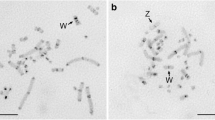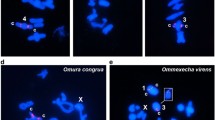Abstract
A highly repetitive, centromerically localized DNA sequence (PR1) has been isolated from the genomic DNA of two species of pigeon (Columba livia andC. palumbus). PR1 is approximately 900 bp long. It includes a sequence that is similar to the CENP-B box of mammals. It represents about 5% of the genome inC. livia and 2% inC. palumbus. In both species, tandem arrays ofPR1 form part of larger repeating units. The organization of PR1 repeats and the larger repeating units is strikingly different in the two species. The large repeating units inC. livia include long (at least 14 units) tandem arrays of PR1 interspersed with relatively short intervening sequences. The large repeats ofC. palumbus have much shorter (4 units or fewer) PR1 arrays interspersed with longer sections of non-PR1 DNA. PR1 is transcribed on short lampbrush loops in the centromeric regions of all lampbrush bivalents ofC. palumbus. InC. livia, it is not transcribed at any of the major pericentromeric sites at which it is known to be present, although it is transcribed at one minor centromeric site on chromosome 2. It is proposed that transcription of the noncoding PR1 sequence on lampbrush chromosomes of pigeons relates to its genomic organization. The proposal is discussed with regard to the ‘read-through’ hypothesis for transcription on lampbrush loops.
Similar content being viewed by others
References
Baldwin L, Macgregor HC (1985) Centromeric satellite DNA in the newtTriturus cristatus karelinii and related species: its distribution and transcription on lampbrush chromosomes.Chromosoma 92: 100–107.
Bruford M, Hanotte O, Brookfield JFY, Burke T (1992) Singlelocus and multilocus DNA fingerprinting. In: Hoezel AR, ed.Molecular Genetic Analysis of Populations. A Practical Approach. Oxford: Oxford University Press, pp 225–270.
Callan HG (1986)Lampbrush Chromosomes. Berlin: Springer Verlag.
Chelysheva LA, Solovei IV, Rodionov AV, Yakovlev AF, Gaginskaya ER (1990) The lampbrush chromosomes of the chicken: the cytological maps of macrobivalents.Cytology 32: 303–316.
Chen Z-Q, Lin CC, Hodgetts RB (1989) Cloning and characterization of a tandemly repeated DNA sequence in the crane family (Gruidae).Genome 32: 646–654.
Chen Z-Q, Ritzel RG, Lin CC, Hodgetts RB (1991) Sequence conservation in avian CR1: an interspersed repetitive DNA family evolving under functional constraints.Proc Natl Acad Sci USA 88: 5814–5818.
Diaz MO, Gall JG (1985) Giant readthrough transcription units at the histone loci on lampbrush chromosomes of the newtNotophthalmus.Chromosoma 92: 243–253.
Diaz MO, Barsacchi-Pilone G, Mahone KA, Gall JG (1981) Transcripts from both strands of a satellite DNA occur on lampbrush chromosome loops of the newtNotophthalmus.Cell 24: 649–659.
Epstein LM, Mahon KA, Gall JG (1986) Transcription of a satellite DNA in the newt.J Cell Biol 103: 1137–1144.
Gaginskaya ER (1972) The nuclear structures of oocytes in adult birds. II. Protein bodies and karyosphere.Cytology 14: 568–578.
Gaginskaya ER, Gruzova MN (1969) Peculiarities of the oogenesis ofFringilla coelebs.Cytology 11: 1241–1251.
Gaginskaya ER, Gruzova MN (1975) The revealing of amplified rDNA in the ovarian cells of some insects and birds by nucleic acidin situ hybridization.Cytology 17: 1132–1137.
Gall JG, Stephenson EC, Erba HP, Diaz MO, Barsacchi-Pilone G (1981) Histone genes are located at the sphere loci of newt lampbrush chromosomes.Chromosoma 84: 159–171.
Gall JG, Diaz MO, Stephenson EC, Mahon KA (1983) The transcription unit of lampbrush chromosomes.Soc Dev Biol Symp 41: 137–146.
Gall JG, Tsvetkov A, Wu Zh, Murphy Ch (1995) Is the sphere organelle/coiled body a universal nuclear component?Dev Genet 16: 25–35.
Hori T, Suzuki Y, Solovei I et al. (1996) Characterization of DNA sequences constituting the terminal heterochromatin of the chicken Z chromosome.Chrom Res, Chrom Res 4: 411–426.
Hutchison NJ (1987) Lampbrush chromosomes of the chickenGallus domesticus.J Cell Biol 105: 1493–1500.
Khutinaeva MA, Kropotova EV, Gaginskaya ER (1989) Morphofunctional organisation peculiarities of the lampbrush chromosomes of oocytes in the pigeon,Columba livia.Cytology 31: 1185–1193.
Kipling D, Mitchell AR, Masumoto H, Wilson HE, Nicol L, Cooke HJ (1995) CENP-B binds a novel centromeric sequence in the Asian mouseMus caroli.Mol Cell Biol 15: 4009–4020.
Longmire JL, Lewis AK, Brown NC et al. (1988) Isolation and molecular characterization of a highly polymorphic centromeric tandem repeat in the family Falconidae.Genomics 2: 14–24.
Madsen CS, de Kloet DH, Brooks JE, de Kloet SR (1992a) Highly repeated DNA sequences in birds: the structure and evolution of an abundant, tandemly repeated 190-bp DNA fragment in parrots.Genomics 14: 462–469.
Madsen CS, McHugh KP, de Kloet SR (1992b) Characterization of a major tandemly repeated DNA sequence (RBMII) prevalent among many species of waterfowl (Anatidae).Genome 35: 1037–44.
Madsen CS, Brooks JE, de Kloet E, de Kloet SR (1994) Sequence conservation of an avian centromeric repeated DNA component.Genome 37: 351–355.
Masumoto H, Masukata H, Muro Y, Nozaki N, Okazaki T (1989) A human centromere antigen (CENP-B) interacts with a short specific sequence in alphoid DNA, a human centromeric satellite.J Cell Biol 109: 1963–1973.
Masumoto H, Yoda K, Ikeno M, Kitagawa K, Muro Y, Okazaki T (1993) Properties of CENP-B and its target sequence in a satellite DNA.NATO ASI Series H,72: 31–43.
Matzke MA, Varga F, Berger H et al. (1990). A 41–42 bp tandemly repeated sequence isolated from nuclear envelopes of chicken erythrocytes is located predominantly on microchromosomes.Chromosoma 99: 131–137.
Ockleford CD, Hsi B-L, Wakely J, Badley RA, Whyte A, Page Faulk W (1981) Propidium iodide as a nuclear marker in immunofluorescence. I. Use with tissue and cytoskeletal studies.J Immunol Methods 43: 261–267.
Penrad-Mobayed M, Sourrouille P, Bonnanfant-Jais ML, N'Da E, Edstrom JE, Angelier N (1991) Microdissection and cloning of DNA from landmark loops of amphibian lampbrush chromosomes.Chromosoma 101: 180–188.
Saitoh Y, Saitoh H, Ohtomo K, Mizuno S (1991) Occupancy of the majority of DNA in the chicken W chromosome by bent-repetitive sequences.Chromosoma 101: 32–40.
Shapira E, Yarus S, Fainsod A (1991) Genomic organization and expression during embryogenesis of the chicken CR1 repeat.Genomics 10: 931–939.
Solovei I, Gaginskaya E, Hutchison N, Macgregor H (1993) Avian sex chromosomes in the lampbrush form: the ZW lampbrush bivalents from six species of bird.Chrom Res 1: 153–166.
Solovei I, Gaginskaya ER, Macgregor HC (1994) The arrangement and transcription of telomere DNA sequences at the ends of lampbrush chromosomes of birds.Chrom Res 2: 460–470.
Solovei I, Macgregor HC, Gaginskaya E (1995) Specifically terminal clusters of telomere DNA sequences are transcribed from the C-rich strand on chicken lampbrush chromosomes. In: Brandham PF, Bennett MD, eds.Kew Chromosome Conference IV. London: Royal Botanic Gardens, pp 323–330.
Tarantul VZ, Gol'tsov VA, Rodionov AV, Chelysheva LA, Khutinaeva MA (1989). Molecular and cytologic analysis of clusters of moderate repeats of bird genomes.Mol Biol 23: 481–90.
Varley JM, Macgregor HC, Nardi I, Andrews C, Erba HP (1980) Cytological evidence of transcription of highly repeated DNA sequences during the lampbrush stage inTriturus cristatus carnifex.Chromosoma 80: 289–307.
Varley JM, Macgregor HC, Barnett L (1990) Characterization of a short, highly repeated and centromerically localized DNA sequence in crested and marbled newts of the genusTriturus.Chromosoma 100: 15–31.
Wu Z, Murphy C, Gall JG (1986). A transcribed satellite DNA from the bullfrogRana catesbeiana.Chromosoma 93: 291–297.
Author information
Authors and Affiliations
Additional information
accepted for publication by M. Schmid
Rights and permissions
About this article
Cite this article
Solovei, I.V., Joffe, B.I., Gaginskaya, E.R. et al. Transcription on lampbrush chromosomes of a centromerically localized highly repeated DNA in pigeon (Columba) relates to sequence arrangement. Chromosome Res 4, 588–603 (1996). https://doi.org/10.1007/BF02261722
Received:
Accepted:
Issue Date:
DOI: https://doi.org/10.1007/BF02261722




